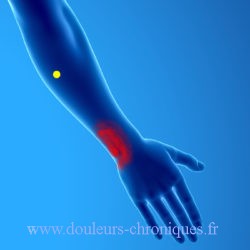Anatomical reminder
Description

1 – Brachioradialis muscle
2 – Extensor carpi radialis longus
3 – Extensor carpi radialis brevis
4 – Abductor pollicis longus
5 – Thumb extensor brevis
6 – Long thumb extensor
7 – Tendon of the extensor of the fingers
8 – 5th finger extensor
9 – Extensor carpi ulnaris
10 – Finger extensor
11 – Ancona
12 – Olecranon
- The extensor carpi radialis longus (2) takes its proximal insertion on the distal third of the lateral supracondylar crest of the humerus, between the lateral epicondyle and the insertion of the brachioradialis muscle. The distal insertion is done on the dorsal part of the base of the 2nd metacarpal. Note that the muscle extends over the 1st tire of the forearm, the other 2 thirds being tendinous.
- The extensor carpi radialis brevis (3) inserts through the common extensor tendon on the lateral epicondyle. Its distal insertion is on the dorsal base of the 3rd metacarpal.
- The extensor carpi ulnaris (9) attaches to the lateral epicondyle via the common extensor tendon. Sin distal insertion is done on the dorsal face of the 5th metatarsal.
- The brachioradialis muscle (1) inserts proximally on the lateral supracondylar crest of the humerus at mid-height of the arm. Distally, the tendon widens and, after making connections with neighboring ligaments, inserts into the radial styloid process.
Functions
The extensor carpi longus and brevis reach into extension and abduction, the extensor carpi ulnaris reach into extension and adduction. The extension function of the carpus is essential for gripping the hand.
The brachio-radialis muscle mainly participates in the flexion of the elbow, it is therefore in synergy with the biceps brachii and the brachialis muscle.
Myofascial syndrome of the extensor muscles of the hand
Description
- Extensor carpi ulnaris

- Extensor carpi radialis brevis

- Extensor carpi radialis longus

- Brachioradialis

Triggers and maintenance factors
Activation by repetitive gestures requiring strong grip, especially if the hand is in the ulnar position (vine pruning, hedge pruning, tennis backhand, etc.). these different movements cause pain called “tennis elbow”
Diagnostic
The handshake test with a radial then ulnar orientation of the hand triggers the pain. A compression of the painful points with this same test makes it possible to make the pain disappear momentarily. The extension of the different muscles or their contraction, shortened muscle, also makes it possible to highlight the myofascial syndrome.
Treatment
- Responsible Muscle Stretches
- Infiltration of lidocaine in the responsible muscle areas followed by stretching.
- Prevention by wearing a bracelet on the wrist limiting extension and complete flexion of the wrist
